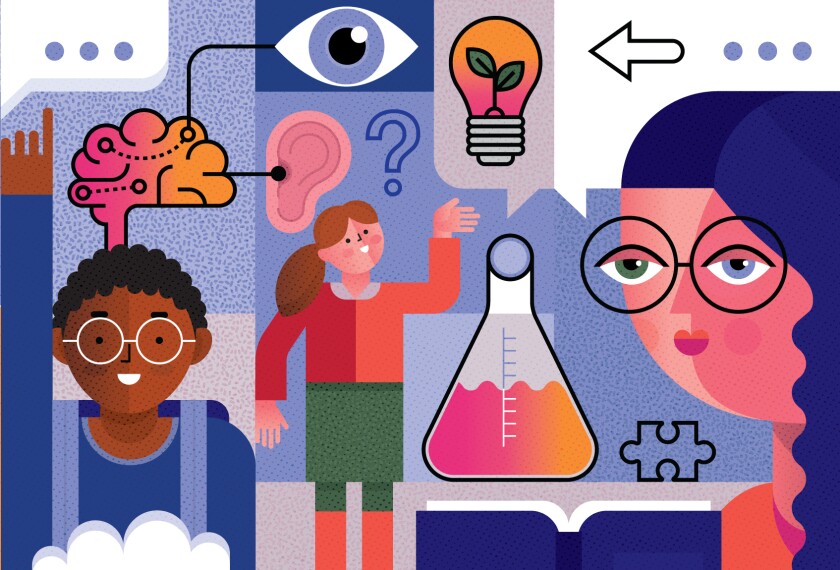When the U.S. space agency pinned badges on the 11 newest members of its astronaut corps this winter, it also increased by three its cadre of educator astronauts.
Three former teachers—Dorothy M. Metcalf-Lindenburger, Richard R. Arnold II, and Joseph M. Acaba—graduated from NASA’s grueling training program. The gauntlet of fitness tests, survival and technical training, and dawn-to-dark studies began shortly after their selection out of thousands of other K-12 educators who had applied to the space program in 2004.
They join Barbara R. Morgan, the first educator-mission specialist, who passed the same training in 2000. Unlike them, Ms. Morgan, 54, has been designated for a space-shuttle mission—an assembly mission for the orbiting International Space Station. NASA says the mission will be the fifth upcoming flight for the often-delayed shuttle program; the official estimate is for the flight to happen later this year or in 2007.
Space flight for the newest astronauts is a more distant prospect, Ms. Metcalf-Lindenburger and Mr. Arnold acknowledged in recent interviews. The two, based at NASA’s Johnson Space Center, near Houston, have not been scheduled for a mission and are part of a long waiting line of astronauts, Mr. Arnold said.
If and when their first space flights do come along, most likely on a mission to the space station, they don’t foresee having the chance to do much direct teaching to students back on Earth.
“Teaching in space—that has yet to be fleshed out,” said Mr. Arnold, 42, who formerly taught mathematics at the American International School in Bucharest, Romania. “We’ve been working really hard getting the shuttle flying again.”
The shuttle program was grounded after the fatal disintegration on re-entry of the shuttle Columbia in 2003. The program was again grounded due to safety concerns after the return to flight in August 2005.
Mr. Arnold noted that as long as the space station, which officials predict will be completed in 2010, maintains staffing levels near the basic crew of one or two, they and the shuttle crews will have to devote nearly all their attention to daily maintenance and upkeep.
If the space station had five or six occupants, “the opportunity for science education would grow exponentially,” Mr. Arnold said.
Astronauts First
Officials of the National Aeronautics and Space Administration don’t dispute the narrow prospects for education activities by astronauts.
“They’re not going up with a set of lesson plans they’re going to teach from space,” said James Stofan, NASA’s acting deputy assistant administrator for education programs, based in Washington.
“Our current educator astronauts are first and foremost astronauts,” he said. “They’re going up to be full-fledged members of the astronaut corps and being able to develop educational outreach experiences based on what their work is.”
They will be more active with schools when they are on the ground—whether before, during, or after NASA missions, he said.
He added that the agency is adding more ground-based educational programs, including “a hip-hop urban rock show” traveling around the country to help students understand Newton’s laws of motion.
Twenty years after the space shuttle Challenger blew up, killing New Hampshire social studies teacher Christa McAuliffe and her fellow crew members, the space agency is still countering a popular image in which teachers would present lessons to students from space. That image was cultivated by NASA’s original Teacher-in-Space program, which selected Ms. McAuliffe for the first spot on a flight and designated Ms. Morgan as her backup.
Howard E. McCurdy, a professor of public affairs at American University, in Washington, and an authority on the history of NASA, said the shuttle program—a potential magnet for young people, with its aim of making space flight relatively accessible—has proven an experimental, risky endeavor, requiring people with the qualities and training of test pilots; by comparison Ms. McAuliffe only trained for 100 hours.
Chemical Reaction
The educator astronauts said they expect to work with teachers, in part, through a network of 194 teachers formed from those who applied to be astronauts in 2004.
Members of the Network of Educator Astronaut Teachers, a volunteer group, receive professional development from the space agency and, in turn, train other teachers. The network holds an annual conference at a NASA facility.
Ms. Metcalf-Lindenburger, 30, who taught science at Hudson’s Bay High School, in Vancouver, Wash., said that she already has much to tell her former colleagues about enlivening math and science. For example, by showing how astronauts use lithium hydroxide to absorb deadly carbon dioxide from breathing systems in space suits and spacecraft, a teacher can make chemical reactions real to students.
“Here is a perfect example of a chemical equation that has an absolutely necessary life-support priority of our system, to survive in space,” she said. “We learn as a kid in high school how to balance a chemical equation, but we don’t know a thing about how it is used.”



